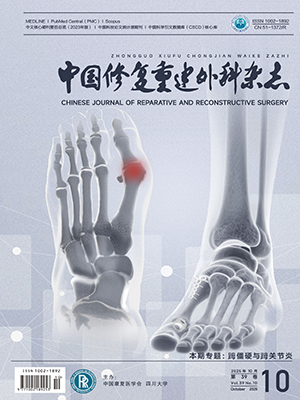Objective To investigate the effect of stretch on long non-coding RNA taurine upregulated gene 1 (TUG1)-mediated miR-545-3p/cannbinoida receptor 2 (CNR2) pathway regulating bone regeneration in the distraction area of rats during distraction osteogenesis. Methods Thirty-six 10-week-old male Sprague Dawley rats were randomly divided into 3 groups (n=12 in each group): group A (femoral fracture+injection of interfering RNA), group B (distraction osteogenesis+injection of interfering RNA), and group C (distraction osteogenesis+injection of TUG1). Groups A and B were injected with 60 μg of interfering RNA at the beginning of incubation period (immediate after operation), the beginning of distraction phase (7 days after operation), and the end of distraction phase (21 days after operation), and group C was injected with 60 μg of synthetic TUG1 in vivo interfering sequence at the same time. The general situation of rats in each group was observed during the experiment. The mineralization of fracture space or distraction area was observed by X-ray films at 21, 35, and 49 days after operation. At 49 days after operation, the samples of the distraction area were taken for HE staining to observe the mineralization, and real-time fluorescence quantitative PCR (qRT-PCR) was used to detect the expressions of osteoblast-related genes such as TUG1, miR-545-3p, CNR2, alkaline phosphatase (ALP), osteocalcin (OCN), and osteopontin (OPN). Blood samples were collected from the abdominal aorta of the rats, and the expressions of ALP and C terminal telopeptide of type Ⅰ (CTX-Ⅰ) protein were detected by ELISA assay.Results The results of X-ray film and HE staining observations showed that osteogenesis in group C was superior to groups A and B at the same time point. The results of qRT-PCR showed that the relative mRNA expressions of TUG1, CNR2, ALP, OCN, and OPN in group C were significantly higher than those in group A and group B, and the relative mRNA expression of miR-545-3p in group C was significantly lower than that in group A and group B (P<0.05). The relative mRNA expressions of TUG1 and ALP in group B were significantly higher than those in group A, and the relative mRNA expression of miR-545-3p in group B was significantly lower than that in group A (P<0.05). There was no significant difference in the relative mRNA expressions of CNR2, OCN, and OPN between group A and group B (P>0.05). The results of ELISA showed that the expressions of ALP and CTX-Ⅰ protein were significantly higher in group C than in group A and group B, and in group B than in group A (P<0.05). Conclusion Under the action of stretch, the expression of TUG1 in the femoral distraction area of rats increases, which promotes the expression of CNR2 by inhibiting the expression of miR-545-3P, which is helpful to the mineralization of the extension area and osteogenesis.
Citation:
ZHANG Mengzhu, WANG Bin, WANG Zixin, WU Yalong, ZHENG Yongxin. Effect of stretch on taurine upregulated gene 1-mediated miR-545-3p/cannbinoida receptor 2 pathway regulating distraction osteogenesis in rats. Chinese Journal of Reparative and Reconstructive Surgery, 2025, 39(5): 598-604. doi: 10.7507/1002-1892.202503010
Copy
Copyright © the editorial department of Chinese Journal of Reparative and Reconstructive Surgery of West China Medical Publisher. All rights reserved
| 1. |
|
| 2. |
|
| 3. |
|
| 4. |
|
| 5. |
|
| 6. |
|
| 7. |
|
| 8. |
|
| 9. |
|
| 10. |
|
| 11. |
|
| 12. |
|
| 13. |
|
| 14. |
|
| 15. |
|
| 16. |
|
| 17. |
|
| 18. |
|
| 19. |
|
| 20. |
|
| 21. |
|
| 22. |
|
| 23. |
|
| 24. |
|
| 25. |
|
| 26. |
|
| 27. |
|
| 28. |
|
- 1.
- 2.
- 3.
- 4.
- 5.
- 6.
- 7.
- 8.
- 9.
- 10.
- 11.
- 12.
- 13.
- 14.
- 15.
- 16.
- 17.
- 18.
- 19.
- 20.
- 21.
- 22.
- 23.
- 24.
- 25.
- 26.
- 27.
- 28.




